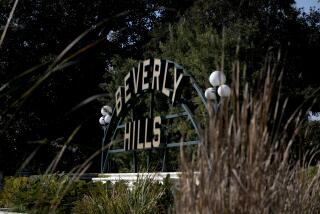Garcetti says state should give tax breaks for quake retrofits
Flanked by property owner and tenants’ rights advocates, Los Angeles Mayor Eric Garcetti urged state lawmakers Wednesday to support a bill that would give owners a 30% tax break off the cost of seismically retrofitting vulnerable buildings.
“We as a city cannot do this alone,” Garcetti told reporters at a news conference Wednesday on the steps of Van Nuys City Hall. “This is a common-sense bill that will set forward a pathway to help building owners, to help landlords and tenants alike, to create a safer and a greater Golden State.”
The bill, introduced by Assemblyman Adrin Nazarian (D-Sherman Oaks), would help owners and tenants with the cost of retrofits. Garcetti has proposed new laws that would require seismic retrofits of wooden apartment buildings within five years and concrete buildings within 30 years in Los Angeles.
“Just one of these buildings collapsing in an earthquake puts one too many lives at risk,” said Nazarian, who called the bill a “proactive and fiscally smart approach.” Owners of single-family and mobile homes that retrofit those structures also would qualify for the tax break.
A similar bill to implement tax breaks for seismic retrofits, AB 1510, was unanimously approved by the Assembly’s revenue and taxation committee last May but was never voted on by the appropriations committee.
But support has grown for the idea this year, now with the public backing of Garcetti and a number of business and tenant groups.
The Apartment Assn. of Greater Los Angeles’ executive vice president, Jim Clarke, said he backed the tax break proposal, which he called important to creating a workable solution to fund the retrofits.
“We heartily support the passage of [Assembly Bill] 428,” Clarke said. “It gets us a step closer to the safety improvements our buildings need.”
Added Larry Gross, executive director of the Coalition for Economic Survival, a tenants’ rights group: “This would help with splitting the costs” between tenants and owners.
Under the proposed bill, the tax credit would be given to the owner over a period of five years after the retrofit is complete. In other words, for every $100 the owner spends on a qualified retrofit, the owner would receive $30 back in a tax break off of income taxes or corporations taxes.
Procedures that would be eligible for a tax break include retrofitting wood-frame apartment buildings, concrete residential buildings, installing automatic gas shutoff valves, anchoring a single-family home to the foundation and installing a quake-resistant bracing system for mobile homes.
Members of the Los Angeles City Council, Bob Blumenfield and Paul Krekorian, said Wednesday that the bill is an important step in answering how these retrofits can be done in an affordable way. The retrofits could cost as much as $130,000 for wooden apartments and millions for taller concrete buildings.
The head of the City Council’s housing committee, Councilman Gil Cedillo, recently pledged that tenants would not face huge rent increases as a result of the earthquake retrofits. The goal, he said, would be to find ways to make it easier for property owners to retrofit their buildings.
Cedillo and Blumenfield also are looking into expanding a program that could provide private loans for retrofitting that would be paid back through a temporary, voluntary increase on their property tax bill.
Because the program allows borrowers to pay the loan back through property taxes instead of to a bank, it lowers costs and allows the loan to remain in place even when a property is sold.
The mayor also has offered other ideas such as giving city tax breaks to commercial tenants who move into retrofitted buildings and protecting low-income tenants from large rent increases.
These retrofitting efforts address an issue that has been known for decades.
The dangers of concrete buildings have been known since the 1971 Sylmar earthquake, when hospital buildings were destroyed. As many as 50 of the more than 1,000 concrete buildings across the city would collapse in a big earthquake, The Times reported in 2013.
Wooden buildings with weak first floors — called “soft-story” buildings and often with carports on the lowest story — are also a well-known risk. Sixteen people were killed when the Northridge Meadows apartment complex pancaked onto the ground floor in the 1994 earthquake. There are as many as 13,000 of these buildings across the city, according to city building officials.
Follow us on Twitter for more news about California earthquake safety: @RosannaXia and @ronlin
More to Read
Sign up for Essential California
The most important California stories and recommendations in your inbox every morning.
You may occasionally receive promotional content from the Los Angeles Times.












